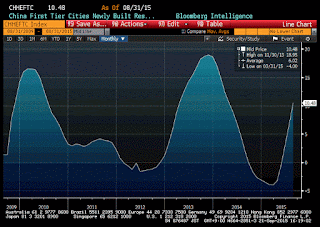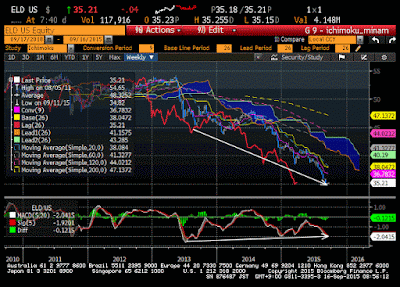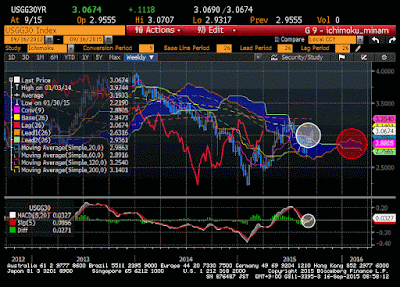According to Yellen's speech last night, she and maybe other FOMC members seem to want to liftoff the interest rate until the end of this year, as given economic conditions. She changed the view about emerging countries from last week's FOMC meeting, to see the woes are not massive to effect on Fed's monetary policy trajectory.
In a conclusion, she said,
"I expect that inflation will return to 2 percent over the next few years as the temporary factors that are currently weighing on inflation wane, provided that economic growth continues to be strong enough to complete the return to maximum employment and long-run inflation expectations remain well anchored. Most FOMC participants, including myself, currently anticipate that achieving these conditions will likely entail an initial increase in the federal funds rate later this year, followed by a gradual pace of tightening thereafter. But if the economy surprises us, our judgments about appropriate monetary policy will change"
In her speech, she implicitly and explicitly argued inflationary dynamic continue to remain about 2% like 1990s and Fed not to forget the history that failing to follow elevated inflation despite there were some clues about that. It means maybe inflation dynamics are not linear. And Fed does not see this circumstance as the deflation. She said core PCE price is going to 2% gradually with downward pressure by temporary factors. U.S. economy is nearby the full employment condition and asset prices and consumption continue to improve, as they emphasized.
What caused this change for her now? Is not the change, but just tapping the market?
I believe Yellen tapped the market, not yesterday, but last week's FOMC meeting. She could be curious that the decision of monetary tightening amid easing environment in other development and emerging countries is right or not, while someone argued interest rate hike was needed for eliminating uncertainty at least. And then, she confirmed the consequence. It was tumbled stock price and weak emerging countries' asset prices and FX values. Furthermore, some economists started to argue the excessive easing policies could deteriorate sentiments of economic growth because of considering low rate as a signal of negative growth momentum. If then, rate hike could spur the economy ironically.
This result maybe enhanced the willingness of start of monetary tightening for Fed... And, in line with diminishing uncertainty, EM assets should not be weak further...
2. U.S. durable goods orders declined last month, but was slightly higher than market expectation.
| Durable Goods NAICS Classification | Aug | Jul | Jun | Aug Y/Y | 2014 | 2013 | 2012 |
|---|---|---|---|---|---|---|---|
| New Orders (SA, %) | -2.0 | 1.9 | 4.1 | -1.9 | 6.8 | 2.2 | 6.3 |
| Transportation | -5.8 | 5.0 | 10.8 | 0.8 | 6.1 | 6.5 | 16.6 |
| Total Excluding Transportation | -0.0 | 0.4 | 1.0 | -3.1 | 7.2 | 0.1 | 2.0 |
| Nondefense Capital Goods | -2.0 | 0.7 | 10.7 | -7.5 | 6.6 | 2.8 | 10.8 |
| Excluding Aircraft | -0.2 | 2.1 | 1.5 | -4.0 | 6.3 | -1.0 | 7.6 |
| Shipments | -0.0 | 1.0 | 0.9 | 1.1 | 4.8 | 2.0 | 6.3 |
| Inventories | 0.0 | -0.2 | 0.4 | 2.5 | 6.1 | 2.4 | 3.8 |
| Unfilled Orders | -0.2 | 0.2 | 0.0 | -1.2 | 11.4 | 6.4 | 7.5 |
3. U.S. new home sales in August was up to high since 2008. Real asset markets, especially property or residential markets seem somewhat solid...
4. European PMI eased...while German IFO moved slightly higher this month.
These pictures show mixed signals for growth rate in 3rd and 4th quarter as economists expect recent growth rate could remain in 2nd half this year with somewhat downside risk.
How about Volkswagen? The possible end of autos with diesel engines could affect on European, especially German automobile industries significantly? or just temporary and once loss from disruption by U.S.?
5. Mario Draghi argued the importance of achieving inflation target in ECB even as use further or expanding monetary easing tools. Just bluffing? due to given, known, or expected higher inflation rate at the end of this year? or he really consider the downside risk on inflation with Chinese worries? This would be the key factor in global financial markets... The volatility would be too high until confirming this during one or two months...
6. Taiwan cut the policy rate since more than 6 years ago. And India is expected to cut the rate further in coming months as well... On going currency war?
7. Putin meets Obama for discussion about Syria and so on.








































